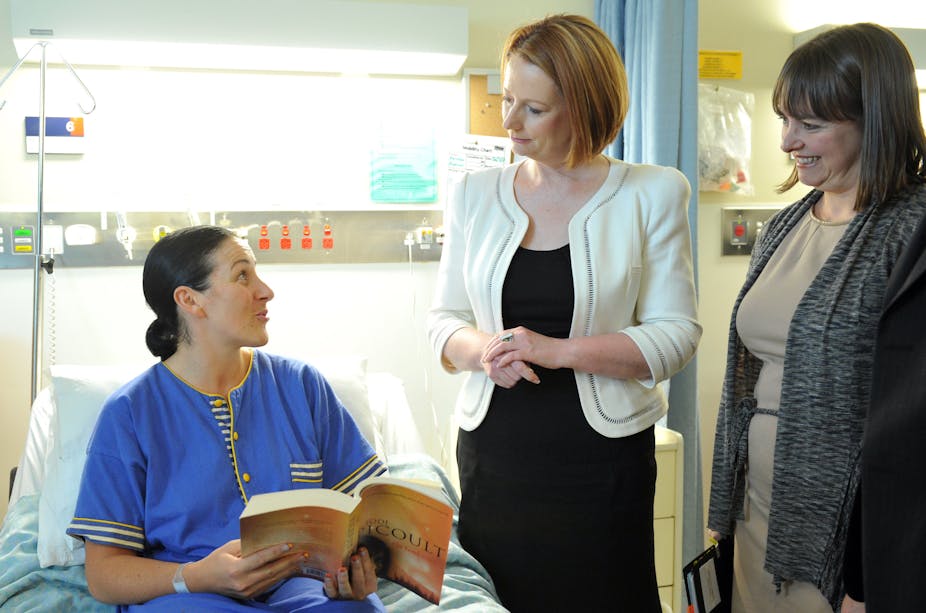The deal’s been done and health reform is in the bag. It may not be quite as bold as originally planned by then prime minister Rudd – there’s even been a fair amount of watering down on Julia Gillard’s watch – but at least we now have nine governments working to a common agenda.
The new agreement on health between the Commonwealth, states and territories has been described by Gillard as leading to “the biggest change to Australia’s health care system since Medicare was introduced in 1984”.
That may be a bold claim, or a sad reflection on how little our health system has changed to keep pace with new pressures and possibilities over the past quarter century.
We will certainly see a lot more money poured into the health sector. An extra $19.8 billion of Commonwealth funding is destined for public hospitals through to 2019-20.
But spending more does not, in itself, constitute reform. Indeed, it may even be counter productive.
A recent review by the United Kingdom National Audit Office found that productivity in its National Health Service (NHS) actually fell by an average of 0.2% a year between 2000 and 2010, which was a period of sizeable increases in health spending.
So it’s good news that Australia’s promised funding boost is to be accompanied by some significant organisational changes.
Local Hospital Networks (LHNs), in particular, embody the prospect of stronger governance and greater local accountability for public hospital services.
And the new Medicare Locals – which will focus on health services in the community – should help to knit together what are often patchy and haphazard arrangements for the delivery of primary care.
Of course, setting up new organisations is no guarantee that performance improvements will follow. It’s what those organisations actually do that really matters.
And that’s where the impact of the current reforms will really be felt – or not, as the case may be.
Activity-based funding of most LHN services will help to ensure that money follows patients.
The fact that payments will be sourced from both Commonwealth and State or Territory coffers and administered from a central funding pool should bring an end to much of the financial bickering that has blighted the sector for so long.
Activity-based funding ought not only to focus LHNs’ attention on their own efficiency but also to encourage them to assess whether specific services might be better delivered by less costly community-based or primary-care providers.
It won’t mean a free-for-all in terms of public hospital services though.
The new National Health Reform Agreement makes it clear that LHNs will be expected to work within Service Agreements negotiated with the relevant State or Territory Government (to which the Commonwealth will explicitly not be a party).
That’s undoubtedly a good thing in terms of ensuring coherent patterns of service and preventing hospitals overreaching in terms of what they can safely deliver.
On the other hand, it could be challenging for local communities which aspire for their local public hospital to offer more complex and comprehensive services.
Medicare Locals, the second key organisational innovation, carry a heavy burden of expectations.
They’re expected to evolve (in most cases) from Divisions of General Practice which have traditionally had a strong focus on supporting general practitioners and, through them, improving the quality of and access to primary care.
Rather than just supporting GPs, Medicare Locals will be required to work with a much broader range of independent health players, drawn largely from the private and not-for-profit sectors.
At the same time, they’ll have to maintain the trust and confidence of local GPs. Indeed, it remains a moot point whether a Medicare Local’s principal constituency is patients who use services or the clinicians and others who provide them.
Those two groups’ interests may not always be aligned. So Medicare Locals will need to think carefully about where their ultimate loyalties lie.
Perhaps the greatest disappointment in the current panoply of health reform initiatives, and arguably the weakest link, is its focus on the supply side of the health sector.
New organisations, some of them paid in new ways, can only ever be a part of the story when it comes to true reform. We’ve seen little, if any, effort directed at the demand side of the health sector.
The reforms will have, at best, marginal and indirect influence on individual choices about when, where and from whom they seek health care; or on the incentives that doctors and other clinicians face when they decide how to treat, what to prescribe or whether to refer.
The new Australian National Preventive Health Agency looks set to follow a “business as usual” approach to behaviour change with efforts directed to social marketing.
But striving to keep people healthy can only ever be part of the story when it comes to the demand for health care. The very concept of what it means to be unhealthy changes over time (a painful hip that was once tolerated in now replaced) and as a result our propensity to seek out care continues inexorably to rise.
The reform cupboard is startlingly bare when it comes to impacts on the real drivers of health-care costs. Tackling those really would result in change of Medicare-like proportions.

